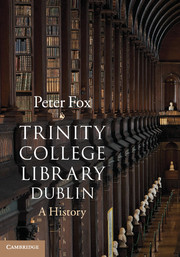Book contents
- Frontmatter
- Dedication
- Contents
- List of illustrations
- List of tables
- Acknowledgements
- Abbreviations
- Introduction
- 1 Early days: 1592–1640
- 2 Ussher, Kells and Durrow: 1641–1665
- 3 Alexander, Bath and the Jacobites: 1666–1708
- 4 A new building: 1709–1737
- 5 Stearne, Gilbert and Lyon: 1738–1749
- 6 The Library in 1750
- 7 Leland to Barrett: 1751–1800
- 8 Fagel: 1798–1809
- 9 Barrett: 1801–1821
- 10 Sadleir, Wall and Todd: 1822–1851
- 11 The Library in 1850
- 12 Todd as Librarian: 1852–1869
- 13 Malet and Ingram: 1869–1886
- 14 Abbott: 1887–1913
- 15 Smyly: 1914–1948
- 16 The Library in 1950
- 17 Parke: 1949–1965
- 18 Professional management: 1965–1983
- 19 Epilogue: 1984–2003
- Appendix 1 Librarians, Assistant Librarians and Deputy Librarians1
- Appendix 2 Growth of the collection
- Appendix 3 The Library oath and declaration
- Sources and select bibliography
- Index of Trinity College Dublin manuscripts
- General index
- Plate Section
- References
5 - Stearne, Gilbert and Lyon: 1738–1749
Published online by Cambridge University Press: 05 June 2014
- Frontmatter
- Dedication
- Contents
- List of illustrations
- List of tables
- Acknowledgements
- Abbreviations
- Introduction
- 1 Early days: 1592–1640
- 2 Ussher, Kells and Durrow: 1641–1665
- 3 Alexander, Bath and the Jacobites: 1666–1708
- 4 A new building: 1709–1737
- 5 Stearne, Gilbert and Lyon: 1738–1749
- 6 The Library in 1750
- 7 Leland to Barrett: 1751–1800
- 8 Fagel: 1798–1809
- 9 Barrett: 1801–1821
- 10 Sadleir, Wall and Todd: 1822–1851
- 11 The Library in 1850
- 12 Todd as Librarian: 1852–1869
- 13 Malet and Ingram: 1869–1886
- 14 Abbott: 1887–1913
- 15 Smyly: 1914–1948
- 16 The Library in 1950
- 17 Parke: 1949–1965
- 18 Professional management: 1965–1983
- 19 Epilogue: 1984–2003
- Appendix 1 Librarians, Assistant Librarians and Deputy Librarians1
- Appendix 2 Growth of the collection
- Appendix 3 The Library oath and declaration
- Sources and select bibliography
- Index of Trinity College Dublin manuscripts
- General index
- Plate Section
- References
Summary
The academic standing of Trinity in the second quarter of the eighteenth century has been dismissed by the standard modern history of the College. ‘It must be confessed that few of the Fellows of the time showed evidence of even a blighted promise or of intellectual creativity,’ say its authors, who claim to have been unable to trace a single word, not even a sermon or a textbook, published between 1722 and 1753 by anyone in possession of a Fellowship. However, even if the written output from those in academic positions in the College was minimal, there was a level of intellectual curiosity and excitement among many who had passed through its doors. In part, this was manifested in a growing passion for book-collecting among members of the clergy, lawyers and doctors, many of whom were Trinity graduates. This group of like-minded individuals patronised the Dublin and London booksellers, with some also buying at continental sales, and in due course theirs was a passion from which Trinity and other institutional libraries in the country were to benefit. The donations to the College from Ashe and Palliser have already been noted, and they were to be followed by Claudius Gilbert's library and the manuscripts and pamphlets acquired by John Stearne. Most of Stearne's printed books and the extensive collection built up by Narcissus Marsh were bequeathed to the library founded by Marsh in Dublin. William King, Marsh's successor as Archbishop of Dublin, owned a library of about seven thousand books which he intended should become a public resource, perhaps in his former diocese of Derry, a place that he considered was more in need of books than the capital. At his death in 1729, however, he had left no specific instructions concerning the library, and so it passed with the rest of his estate to his nephew Robert Dougatt, Keeper of Marsh's Library, and subsequently to Dougatt's nephew Robert Spence, who sold about six thousand of the books to Theophilus Bolton, Archbishop of Cashel, some time in the 1730s. Bolton added them to his own substantial collection to create a new diocesan library which, though it has enjoyed mixed fortunes over the succeeding centuries, continues to survive in Cashel as the Bolton Library.
- Type
- Chapter
- Information
- Trinity College Library DublinA History, pp. 73 - 89Publisher: Cambridge University PressPrint publication year: 2014



